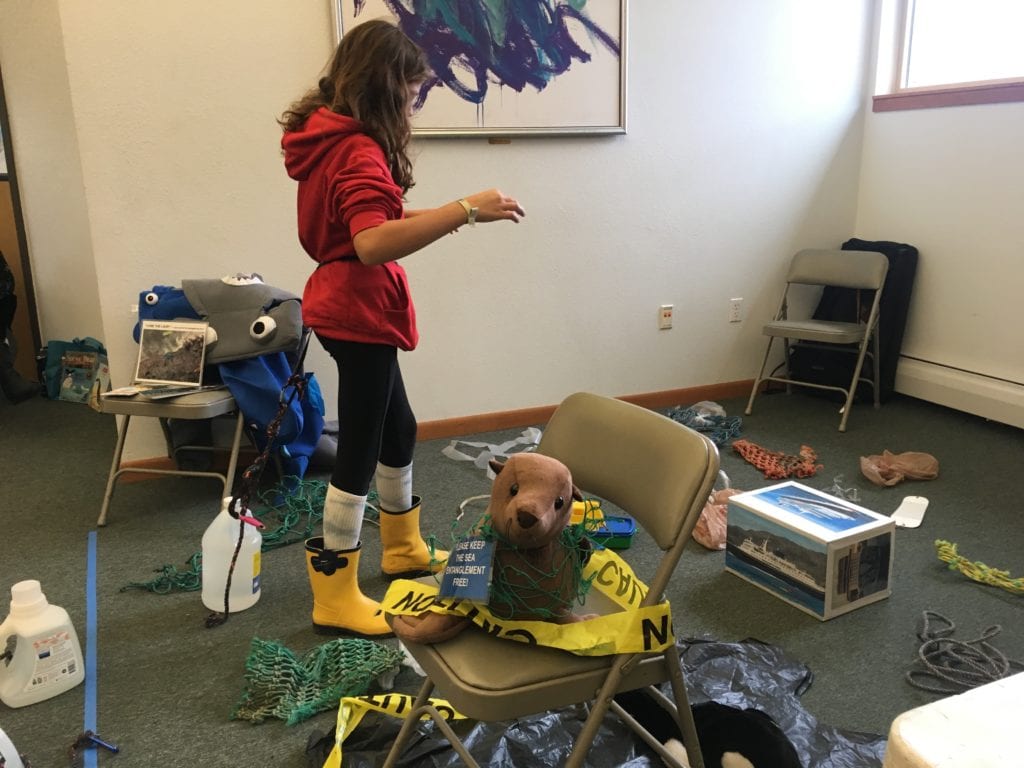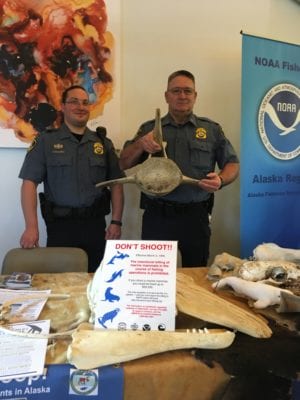
More than 1,100 citizen scientists turned out in light rain in Anchorage on Saturday, Sept. 21 to help NOAA Fisheries and others concerned about endangered beluga whales to count them at 14 scientist-manned stations along Cook Inlet.
“Our hot spot this year was Bird Point,” said Julie Speegle, public affairs officer for NOAA Fisheries’ Alaska regional office in Juneau. “There were 34 beluga sightings there and 337 people.”
This third annual NOAA Fisheries event aims to bring together residents of Southcentral Alaska to educate them on the plight by getting them talking with fisheries biologists manning the watch stations along Cook Inlet.
Following the beluga count in the morning, with a preliminary total of 58 whales spotted, there was a Belugas Festival at the Alaska Zoo, with events for children ranging from story time to a marine debris obstacle course.

Back in October 2008 Cook Inlet beluga whales were listed by NOAA Fisheries as endangered under the Endangered Species Act. Cook Inlet belugas historically numbered 1,000 to 2,000 animals. In the late 1990s the population declines to a few hundred whales, due largely to unsustainable subsistence harvests in the mid-1990s, NOAA officials said.
Scientists estimate there are currently between 300 and 400 beluga whales in Cook Inlet. These whales have been designated by NOAA Fisheries as one of eight “Species in the Spotlight” – species who need a concerted effort from individuals, agencies, groups, tribes, institutions and organizations to survive.
The goal of the Beluga Count is to have partners and interested members of the public work together to help these whales recover.
Among the participants was the Alaska Beluga Monitoring Partnership, (akbmp.org), a collaboration of several organizations offering opportunities for volunteer citizen scientists to join in monitoring the endangered belugas, who are considered a distinct population segment.
Others partners included NOAA Fisheries, Alaska Department of Fish and Game, The Alaska Zoo, Alaskans for Palmer Hayflats, Alaska SeaLife Center, Alaska Wildlife Alliance, Alaska Wildlife Conservation Center, Anchorage Water and Wastewater Utility, Audubon Alaska, Anchorage Waterways Council, Beluga Whale Alliance, Bureau of Ocean Energy Management, Cook Inlet Beluga Photo-ID Project, Defenders of Wildlife, Friends of the Anchorage Coastal Wildlife Refuge, Georgia Aquarium, Glacier Oil and Gas, HilCorp, Mystic Aquarium, SeaWorld, Shedd Aquarium, U.S. Forest Service, University of Alaska Kachemak Bay Campus, and committed individuals.
Belugas are a small toothed whale, also known as the white whale because of the white coloration of adults. Beluga caves born from June through October have a dark to brownish gray coloring which becomes lighter as they get older and eventually turns white. Adult belugas are about 12- to 14-feet long, weigh about 3,000 pounds and may live 60 years or more. Their diet consists of a wide variety of fish and invertebrates, including eulachon (hooligan or candlefish) and Pacific salmon when they are abundant in the spring and summer. Little information is available on their prey in winter months.
The Recovery Plan for the Cook Inlet Beluga Whale, released in December 2016, is online at fisheries.noaa.gov/resource/document/recovery-plan-cook-inlet-beluga-whale-delphinapterus-leucas. The plan identifies a strategy, goals, criteria and actions targeted at recovering these whales.





